Varanasi Ghats: Embark on a spiritual odyssey to the heart of India, where the ancient city of Varanasi unfolds. A timeless testament to faith, tradition, and the enduring human spirit, Varanasi rests on the banks of the sacred Ganges River. Here, the soul of the city beats at its Ghats – majestic steps leading down to the holy water.
Varanasi, also known as Kashi or Banaras, is whispered to be among the oldest continuously inhabited cities on Earth. Its Ghats have silently stood witness to millennia of history, spirituality, and the ebb and flow of countless cultures.
Join us as we delve into the enchanting tapestry of Varanasi’s Ghats. Each step resonates with whispers of devotion, and every moment is a profound immersion into the city’s spiritual essence. We’ll unveil the timeless beauty, vibrant cultural tapestry, and profound significance that make these Ghats truly one-of-a-kind.
How to reach:
- Air: Lal Bahadur Shastri International Airport (VNS) welcomes domestic flights from major cities like Delhi, Mumbai, Kolkata, Chennai, Bangalore, and Hyderabad. International connections to Southeast Asia and the Middle East are also available. Taxis and app-based cabs provide convenient onward journeys to Varanasi.
- Train: Varanasi Junction (BSB), a bustling railway hub, offers frequent connections to major Indian cities like Delhi, Mumbai, Kolkata, Chennai, Hyderabad, and Bangalore. Long-distance and superfast trains further enhance accessibility. Taxis, auto-rickshaws, and cycle-rickshaws are readily available at the station for onward travel.
- Road: Varanasi’s network of national and state highways ensures smooth travel from nearby cities. Buses operated by the Uttar Pradesh State Road Transport Corporation (UPSRTC) connect Varanasi to Allahabad, Lucknow, Kanpur, Gorakhpur, and Agra. Private taxis and app-based cabs offer comfortable alternatives.
Exploring Varanasi:
Once in Varanasi, navigating the city is a breeze. Auto-rickshaws, cycle-rickshaws, and taxis are easily found for short trips. Explore the city at your own pace on foot, or immerse yourself in the unique atmosphere by hiring a boat to explore the Ghats and the Ganges River.
Best time to visit:
- Pleasant Winters (October – March): This period offers the most comfortable weather for exploring Varanasi. Temperatures range from a refreshing 5°C to a comfortable 20°C, making it ideal for sightseeing and navigating the city’s intricate lanes and Ghats. Take advantage of the cool weather by enjoying boat rides on the Ganges or witnessing the mesmerizing Ganga Aarti ceremonies in the evenings.
- Hot Summers (April – June): Varanasi experiences scorching summers with temperatures exceeding 40°C. While outdoor activities become less appealing due to the heat, you can still visit if you’re prepared. Pack light, breathable clothing, sunscreen, and stay hydrated throughout your trip.
- Monsoonal Rejuvenation (July – September): Monsoon brings a welcome respite from the summer heat with heavy rainfall, although humidity remains high. Sightseeing and boat rides might be impacted, and there could be instances of waterlogging. If you don’t mind the rain and seek a unique Varanasi experience, pack an umbrella or raincoat.
Festive Delights:
Varanasi pulsates with vibrant festivals year-round. Diwali, Durga Puja, Holi, and Makar Sankranti are some of the major celebrations that draw devotees and tourists alike. Be prepared for larger crowds during these festivities.
Attractions:
Dashashwamedh Ghat:
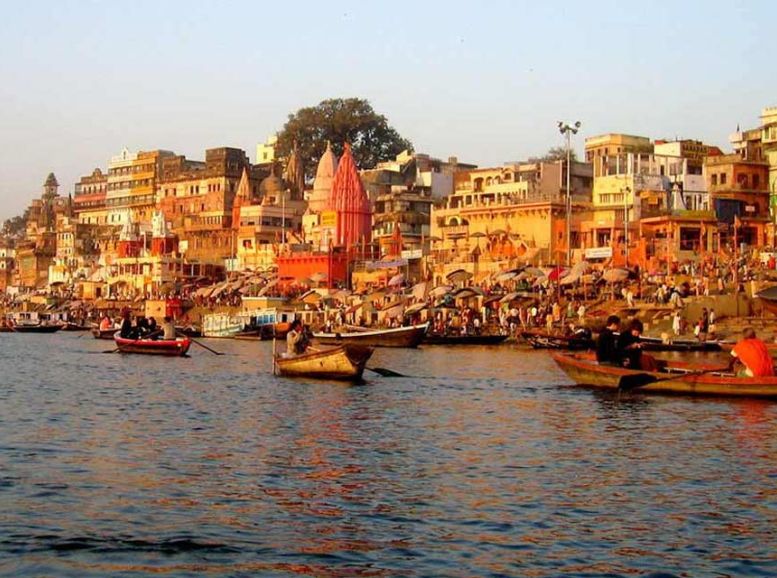
Steeped in history and cultural significance, Dashashwamedh Ghat stands as one of Varanasi’s most ancient and important riverside landings. Legend tells us Lord Brahma himself performed a grand sacrifice, the Dasa-Ashwamedha Yagna, right here – lending the Ghat its name. Today, the site pulsates with vibrant energy, particularly in the evenings when the awe-inspiring Ganga Aarti ceremony unfolds. Witnessing rows of lamps dedicated to the river, accompanied by chants and hymns, is a truly mesmerizing experience that draws pilgrims and tourists alike.
Assi Ghat:
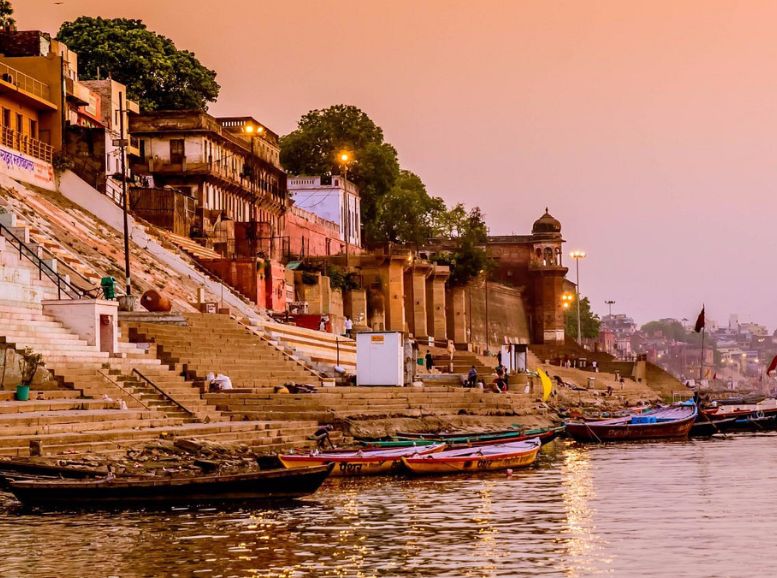
Bustling with life, Assi Ghat stands out as one of Varanasi’s most popular riverside destinations. Nestled at the meeting point of the Assi and Ganges rivers, this Ghat holds a special place in Hindu legend. Tradition recounts that revered sage Tulsidas composed the epic Ramcharitmanas here. Today, Assi Ghat’s vibrant atmosphere attracts visitors seeking a quintessential Varanasi experience. Take a scenic boat ride on the Ganges, delve into the city’s spiritual essence, or simply soak up the lively energy – Assi Ghat caters to all.
Manikarnika Ghat:
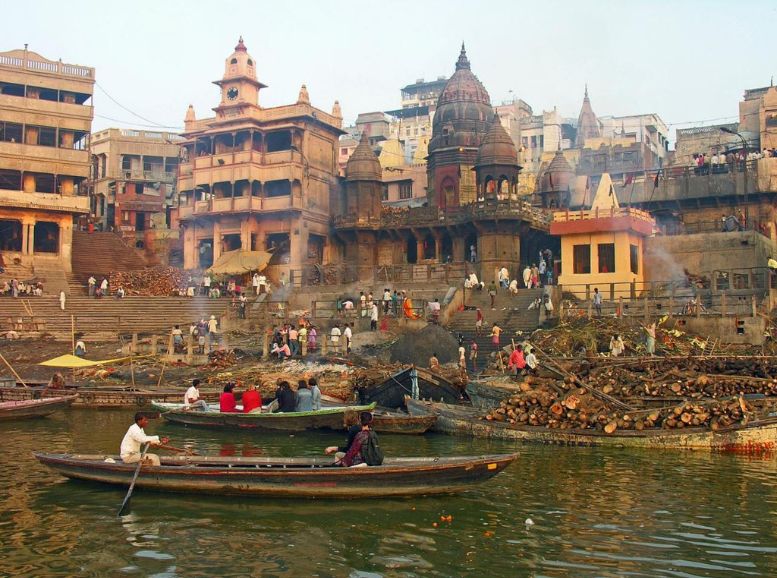
Steeped in both history and spiritual significance, Manikarnika Ghat holds immense importance in Varanasi. Legends narrate that Lord Shiva and Goddess Parvati once graced this very spot. However, Manikarnika Ghat is primarily known today as a cremation ground – the final resting place for many Hindus seeking liberation from the cycle of rebirth. A constant hum of activity underscores this belief, with families performing last rites for their loved ones amidst the burning pyres. Witnessing this sacred ritual offers a profound glimpse into Hindu traditions and the circle of life.
Harishchandra Ghat:
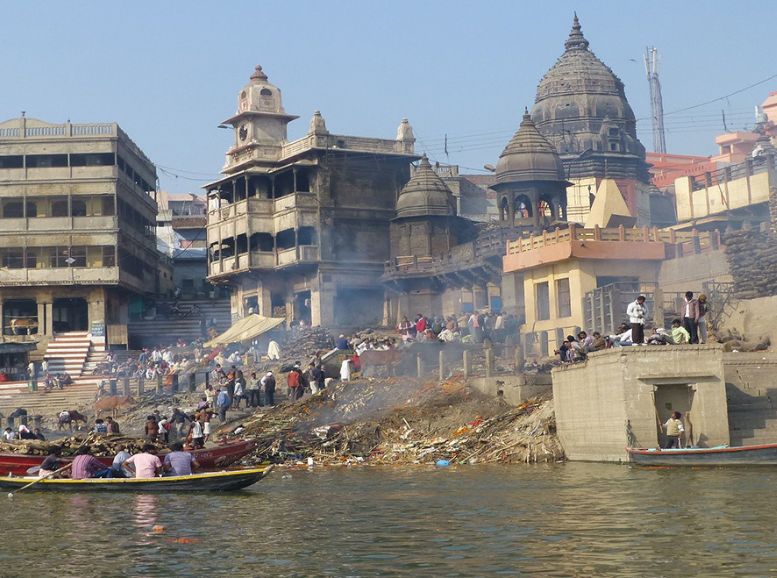
Sharing the solemn purpose of Manikarnika Ghat, Harishchandra Ghat stands as another significant cremation ground in Varanasi. Named after the revered King Harishchandra, a paragon of truth and virtue, the Ghat carries a weight of history. Here, the constant flicker of funeral pyres serves as a poignant reminder of life’s impermanence. The serene yet somber atmosphere allows visitors to contemplate the cycle of existence according to Hindu beliefs.
Panchganga Ghat:
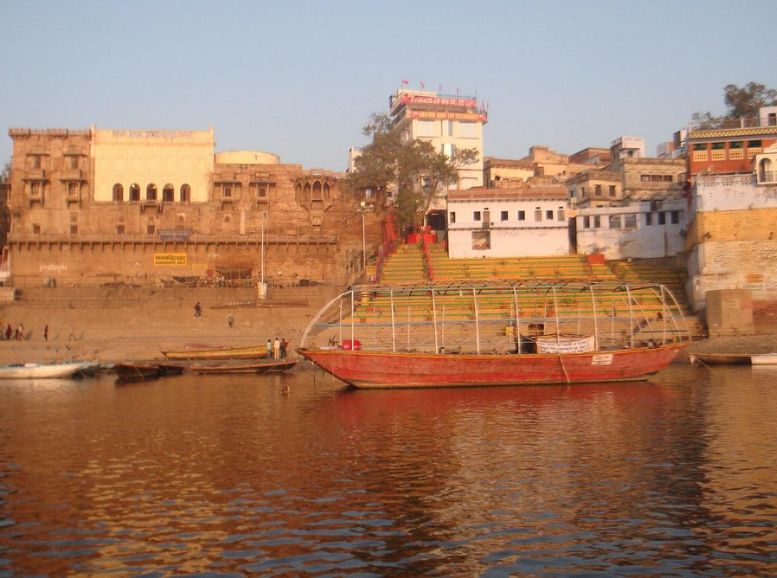
Among Varanasi’s most sacred Ghats is Panchganga, revered for the confluence of five holy rivers – the Ganges, Yamuna, Saraswati, Kirana, and Dhutpapa. Hindu belief holds that bathing in these combined waters cleanses sins and paves the way for moksha (liberation). The Ghat itself is adorned with ancient shrines and temples, including the Panchganga Temple dedicated to Lord Shiva, adding to its spiritual significance.
Darbhanga Ghat:
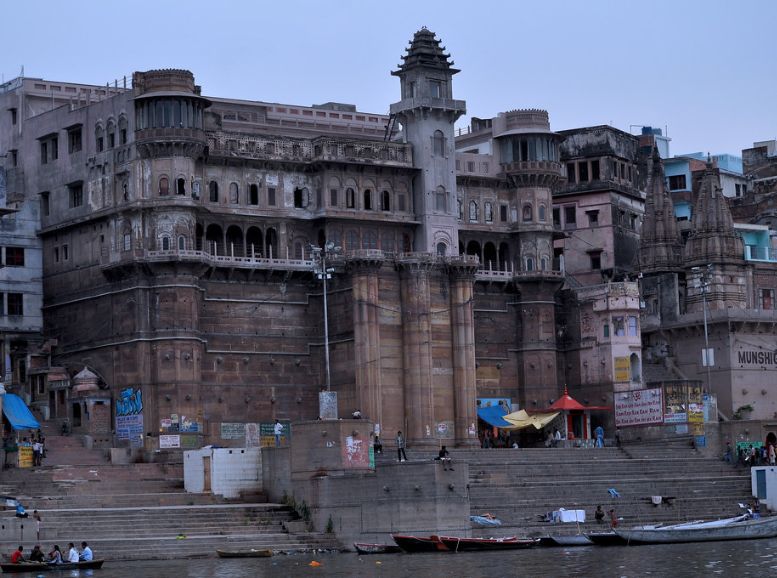
Standing out for its beauty and meticulous upkeep, Darbhanga Ghat graces the banks of the Ganges. Built by the Darbhanga royal family, this ghat boasts stunning architecture and captivating carvings. Elegant palaces and temples line the ghat, with the Darbhanga Palace itself transformed into a luxurious hotel. Darbhanga Ghat offers a tranquil and picturesque haven for visitors seeking to soak in the serenity of the Ganges and appreciate the city’s architectural heritage.
Manmandir Ghat:
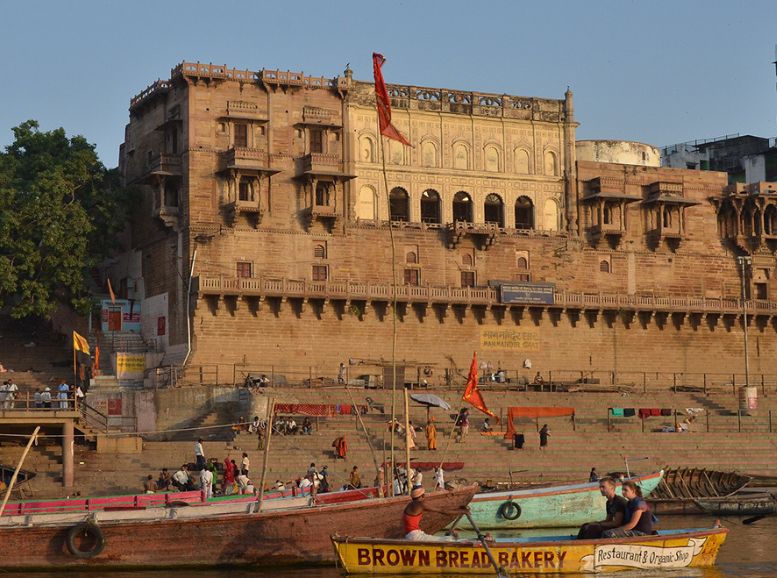
Steeped in history and architectural intrigue, Man Mandir Ghat stands as one of Varanasi’s most ancient landmarks. Erected in the 16th century by Maharaja Man Singh of Amber, the ghat’s very name pays homage to the Man Singh Observatory that graces its grounds. This unique blend of Hindu and Mughal architectural styles manifests in ornate balconies, pavilions, and even minarets, creating a visually captivating spectacle. Beyond its artistic merit, Man Mandir Ghat offers photographers a dream vantage point, capturing panoramic views of the majestic Ganges.
Scindia Ghat:
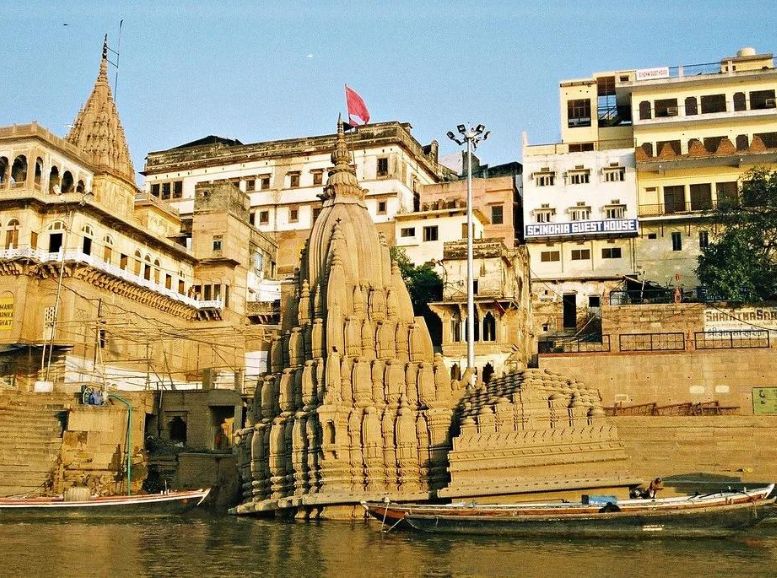
Built in the 19th century by the Scindia dynasty of Gwalior, Scindia Ghat is a prominent landmark on the Ganges. Its elegant architecture and cultural significance draw visitors from all corners. The ghat’s centerpiece is a renowned Shiva temple, dedicated to Lord Kashi Vishwanath, a revered deity in Varanasi. Devotees flock here to take holy dips in the sacred river and perform rituals on the beautiful sandstone steps leading down to the Ganges.
Chet Singh Ghat:
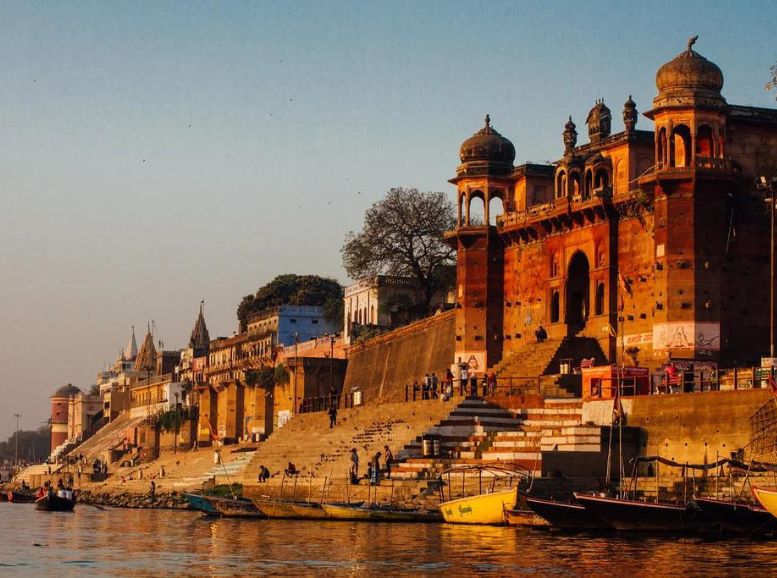
Steeped in history and architectural grandeur, Chet Singh Ghat graces the Ganges with its presence. Named after Maharaja Chet Singh, the 18th-century ruler of Benares, the ghat boasts the once-majestic Chet Singh Palace as its centerpiece. Though time has worn on the palace, its remnants still exude a captivating charm. Today, Chet Singh Ghat offers a tranquil atmosphere, ideal for visitors seeking a moment of peace and reflection while soaking in the beauty of the sacred river.
Rajghat: Varanasi Ghats
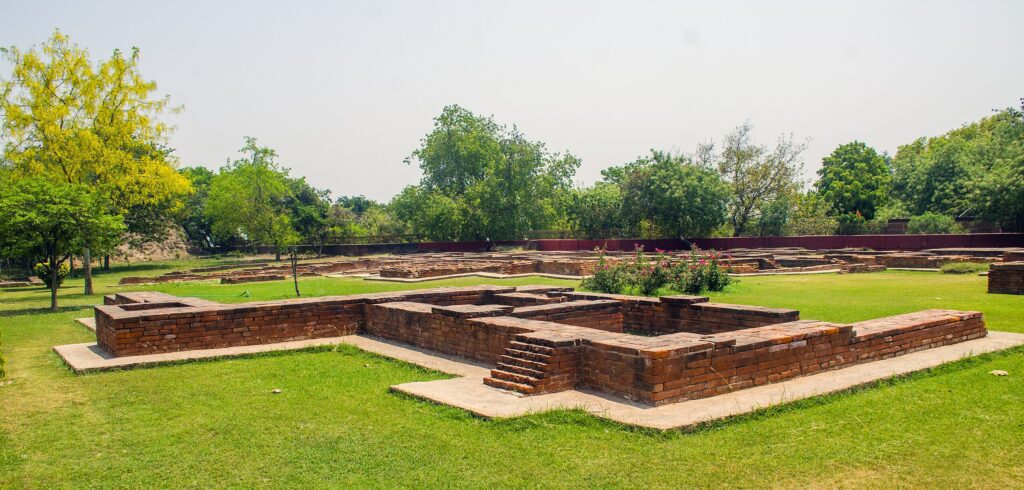
Tucked away near the Malviya Bridge, Rajghat offers a quieter side of Varanasi’s vibrant ghats. Unlike its more famous counterparts, Rajghat boasts a serene atmosphere, perfect for leisurely strolls and soaking in the scenic beauty of the Ganges. This lesser-known gem is a favorite amongst locals and tourists seeking a respite from the usual hustle and bustle. The ghat’s name honors Pandit Madan Mohan Malviya, the esteemed freedom fighter who established the Banaras Hindu University (BHU).
Local Experiences:
- Traverse the Ganges by Boat at Varanasi Ghats: Embark on a boat ride on the Ganges, a journey that brings the ancient Ghats to life. Witness the rhythmic pulse of the city unfold – devotees performing rituals, pilgrims seeking blessings in the holy water, and Sadhus meditating in quiet contemplation. This unique perspective unveils Varanasi’s vibrant culture and spirituality from the heart of the river.
- Witness the Enchanting Ganga Aarti at Varanasi Ghats: Immerse yourself in the mesmerizing Ganga Aarti ceremony. Held at dusk, this evening ritual features priests offering prayers and rows of lamps illuminating the Ganges, accompanied by soulful chants and music. Dashashwamedh Ghat is a popular venue, but the ceremony’s magic unfolds at other Ghats like Assi and Manikarnika as well. Witnessing hundreds of flickering lamps dancing on the river as the sun dips below the horizon is a truly unforgettable experience.
- Embrace the Serenity of a Morning Walk at Varanasi Ghats: Capture the tranquility of the Ghats with an early morning walk. As Varanasi awakens, witness locals performing their daily rituals, practicing yoga, and going about their lives. The hushed pre-dawn hours offer a peaceful atmosphere to absorb the spiritual energy and witness the breathtaking sunrise paint the Ganges in a golden glow.
- Explore the Untrodden Path at Varanasi Ghats: Venture beyond the famed Dashashwamedh and Assi Ghats. Unveiling the hidden gems like Kedar Ghat, Jain Ghat, and Rana Mahal Ghat allows you to experience Varanasi in a more intimate way. Interact with locals engaged in traditional activities, witness unique rituals, and capture captivating views of the river and cityscapes.
- Partake in a Spiritual Offering at Varanasi Ghats: Deepen your connection with Varanasi’s spiritual core by participating in a Puja ceremony at one of the Ghats. Local priests can guide you through personalized ceremonies, from simple offerings of flowers and incense to elaborate rituals with chanting and fire. Participating in a Puja is a deeply enriching experience that allows you to connect with the city’s soul on a more meaningful level.
- Witness the Majesty of Sunrise and Sunset at Varanasi Ghats: Don’t miss the magic of sunrise and sunset over the Ghats. Witness the city come alive as the first rays of dawn bathe the Ghats in soft light, and devotees and Sadhus begin their morning rituals. In the evening, watch the sky transform into a canvas of vibrant colors as the sun dips below the horizon, casting a warm glow on the river and Ghats. These are moments of pure serenity that encapsulate the essence of Varanasi.
Travel tips:
- Dress Modestly: As a sacred city, Varanasi values respectful attire. Opt for clothing that covers shoulders and knees for both men and women.
- Photography Courtesy: While capturing memories is tempting, always seek permission before photographing individuals, especially Sadhus (holy men) and locals engaged in religious practices. Some areas, particularly during ceremonies, may have photography restrictions.
- Secure Your Belongings: Large crowds and narrow lanes are common. Keep your belongings secure and avoid carrying excessive cash or valuables. Be cautious of pickpockets, especially in bustling areas.
- Hydration is Key: Varanasi’s heat, especially during summer, can be draining. Carry a refillable water bottle and stay hydrated throughout the day, particularly if you plan on spending extended time outdoors.
- Choosing the Right Time: The Ghats unveil their magic during the cooler hours. Opt for early mornings or evenings to experience the serene atmosphere and avoid the peak afternoon heat.
- Beware of Touts: Touts and scams can be a nuisance. Avoid engaging with unauthorized guides or boatmen who might overcharge or pressure you into visiting shops for commissions. It’s best to book tours and activities through reputable sources.
- Guided Exploration: Consider a guided tour to gain deeper insights into the Ghats’ history, significance, and local culture. A knowledgeable guide can navigate the maze-like lanes and share valuable perspectives.
- Respectful Observation: Manikarnika and Harishchandra Ghats are primary cremation grounds. Maintain a respectful distance during ceremonies and refrain from taking photos to honor the privacy of grieving families.
- Embrace the Crowds: Varanasi throbs with life, especially during festivals and ceremonies. Be prepared for crowds and navigate them patiently. Major events like Ganga Aarti and festivals can get quite crowded.
- COVID-19 Safety: With the ongoing pandemic, adhere to local COVID-19 guidelines and protocols while visiting the Ghats. Wear a mask, maintain social distance, and use hand sanitizer frequently to ensure your safety and that of others.
Conclusion
Immerse yourself in the heart and soul of India’s spiritual capital with a visit to the captivating Varanasi Ghats. Witness the vibrant rituals and serene beauty of the Ganges River, from the mesmerizing Ganga Aarti ceremony at Dashashwamedh Ghat to exploring hidden gems like Assi Ghat or taking a peaceful boat ride. The Ghats are more than just steps; they’re a timeless dance of life and death, tradition and modernity. Embark on this unforgettable journey with Xplro.com and let our knowledgeable guides navigate the city, share captivating stories, and ensure a respectful and enriching experience. Let the Ganges wash away your worries as you discover, reflect, and find enlightenment in one of the world’s oldest and most sacred cities
FAQs
How many Ghats are there in Varanasi?
Varanasi Ghats boasts around 87 Ghats lining the western bank of the Ganges River, each with its own unique significance and history.
What is the best time to visit Varanasi Ghats?
The best time to visit Varanasi Ghats is during the winter months, from October to March, when the weather is cool and pleasant, making it ideal for sightseeing and exploring the Ghats.
How can I reach Varanasi Ghats?
Varanasi is well-connected by air, rail, and road. The nearest airport is Lal Bahadur Shastri International Airport (VNS), and Varanasi Junction (BSB) is the main railway station. From there, you can easily reach the Ghats by auto-rickshaw, cycle-rickshaw, or taxi.
What are the main attractions near Varanasi Ghats?
Some of the main attractions near Varanasi Ghats include the Kashi Vishwanath Temple, Sarnath, Ramnagar Fort, Tulsi Manas Temple, Bharat Mata Temple, and the Ganga Aarti ceremony at Dashashwamedh Ghat.
What is the significance of Ganga Aarti at Varanasi Ghats?
The Ganga Aarti ceremony is a mesmerizing ritual of light and sound performed every evening at the Ghats. It involves priests offering lamps to the Ganges River, accompanied by chanting and music, and is believed to purify the soul and bring blessings to the devotees.
Can I take a boat ride on the Ganges River at Varanasi Ghats?
Yes, boat rides are a popular way to experience the Varanasi Ghats. You can hire a boat and explore the Ghats from the river, witnessing the ancient rituals and ceremonies up close.
Are there any hidden or lesser-known Ghats in Varanasi?
Yes, apart from the main Ghats, there are several hidden or lesser-known Ghats in Varanasi that offer a more authentic and intimate experience of the city. Some of these include Kedar Ghat, Jain Ghat, and Rana Mahal Ghat.
What are some local experiences I can enjoy at Varanasi Ghats?
Some local experiences you can enjoy at Varanasi Ghats include attending the Ganga Aarti ceremony, taking a morning walk along the riverbank, exploring the hidden Ghats, participating in a Puja ceremony, and witnessing the sunrise and sunset.
Are there any specific customs or guidelines I should follow while visiting Varanasi Ghats?
Yes, visitors are advised to dress modestly, respect local customs and religious practices, be mindful of photography, and avoid engaging with touts and scams. It’s also important to respect the solemnity of cremation ceremonies at Manikarnika Ghat and Harishchandra Ghat.
Is it safe to visit Varanasi Ghats?
Yes, Varanasi Ghats are generally safe for visitors. However, it’s important to be cautious of pickpockets and scams, especially in crowded areas. It’s also advisable to follow basic safety precautions and keep your belongings secure.
What is the significance of the cremation Ghats in Varanasi?
Manikarnika Ghat and Harishchandra Ghat are the primary cremation Ghats in Varanasi, where Hindus from all over India come to perform the last rites of their loved ones. The continuous burning of funeral pyres symbolizes the cycle of birth, death, and rebirth according to Hindu beliefs.
Can I visit Varanasi Ghats during festivals and special events?
Yes, visiting Varanasi Ghats during festivals and special events can be a unique and enriching experience. Some of the major festivals celebrated in Varanasi include Diwali, Durga Puja, Holi, and Makar Sankranti, and the Ghats come alive with vibrant celebrations and rituals during these times.



